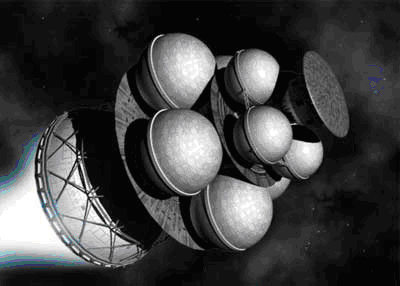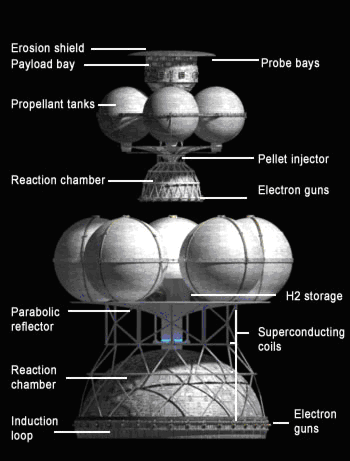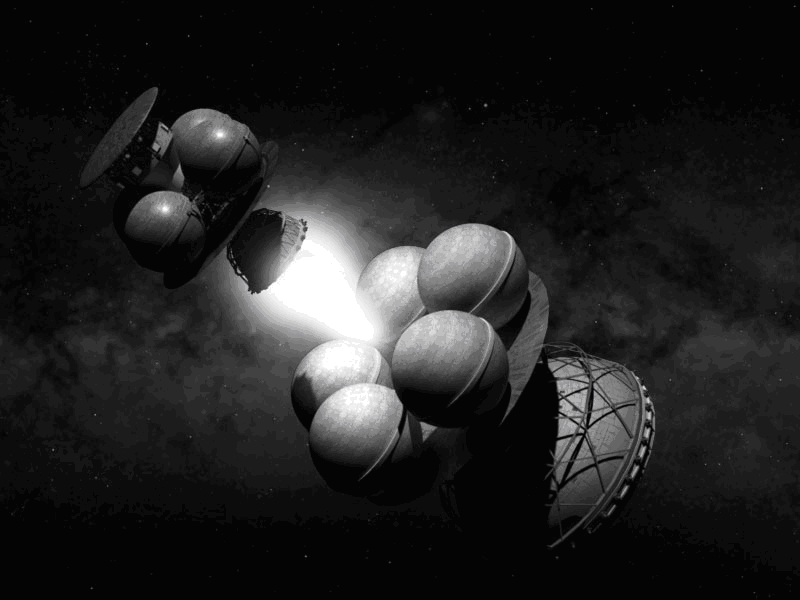Propulsion System
The aim of the Interstellar Data Express Epsilon Eridani Space Probe (EESP) is to reach Epsilon Eridani (10.5 light years from Earth) in 93.1842 years.[1] The EESP, which will be similar to the Daedalus spacecraft, as shown in Figure 1, will be the world's first unmanned spacecraft to reach the Epsilon Eridani system. The support structures and engine bells of the EESP will be composed of molybdenum TZM alloy, which is able to maintain its strength over the severe temperatures, ranging from 0 K to 1,600 K, which the EESP will experience throughout its journey.[2]
Stages 1 and 2 of the EESP are shown in Figure 2. After reaching Jupiter's orbit, the mass of the EESP will be about 54,000 metric tons, which contains scientific payload and fuel consisting of 500 metric tons and 50,000 metric tons, respectively.[3]
As shown in Figure 2, stage 2 of the EESP will include computers, payload, and robots. Each stage of the EESP will include two automated robots to fix problems that may occur during the journey to Epsilon Eridani. The master computer is a comprehensive navigator which will operate the entire EESP and control the robots (shown in Figure 5 below) to fix problems and collect, process, and transmit data back to the receiver. During the flight, the payload and engine on stage 2 of the spacecraft will be shielded from the impact of meteroids and dust using an erosion shield which will be composed of 7 mm thick beryllium weighing 50 metric tons.[3]
As shown in Figure 2, the engines for both stages will be located in the back and propellant tanks will be located on the side. There will be two stages of the EESP that will be sent separately to Jupiter's orbit using liquid H2 fuel. After reaching Jupiter's orbit, the liquid H2 fuel storage tanks will be jettisoned to reduce the weight of the spacecraft, and the two stages will be assembled together, as shown in Figure 3. Figure 4 shows stages 1 and 2 assembled together and traveling in space.[3]
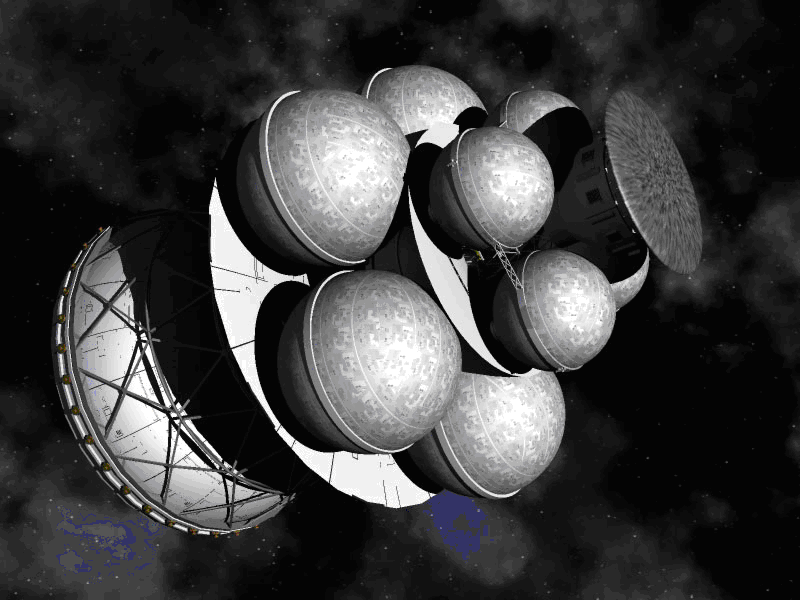
Figure 3. Stage 1 and 2 are assembled and ready to leave Jupiter's orbit.[3]

Figure 4. Stage 1 and 2 are assembled together and traveling in space.[3]
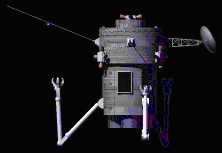
Figure 5. Autonomous robots which will fly around the main ship and fix problems. Each robot will be powered by an on-board RTG and will weigh 10 metric tons.[3]
After reaching Jupiter's orbit, the EESP's engines will employ a nuclear pulse rocket.[3] The nuclear fusion reactions will use tiny pellets of deuterium and helium-3 as a fusion fuel that will be ignited one at a time in the combustion compartment using inertial confinement via high-power electron beams, causing each pallet to explode.[3][4][7] During this process, about 250 particles will be exploded every second. The spacecraft will be propelled by driving high-speed plasma through the magnetic nozzle.[5][6] The aforementioned process is described in Figure 6. It will take 20 years for the helium-3 to be collected from Jupiter's atmosphere because the amount of helium-3 present on earth is small, and a huge amount of it will be required for the spacecraft to operate. Therefore, stage 1 and stage 2 of the EESP will have to be assembled in the region of Jupiter.[3][5]
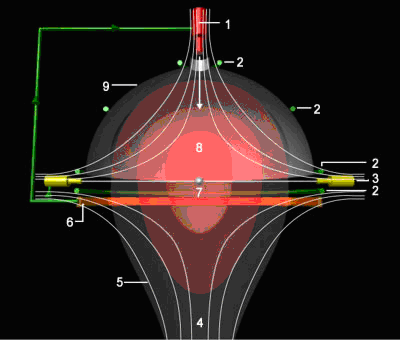
Figure 6. The EESP's engines will employ a nuclear pulse rocket. Label 1 is the pellet injection gun, 2 is the superconducting field coils, 3 is the electron beam generators, 4 is the magnetic field, 6 is the energy extraction coils, 7 is the frozen nuclear pellet, 8 is the nuclear explosion, and 9 is the reaction chamber.[3]
The initial stage will accelerate the spacecraft to 0.071 times the speed of light over the period of two years and utilize 46,000 metric tons of Deuterium/Helium-3 fuel pellets. Thereafter, the engine will be turned off and initial stage equipment will be discarded. During the subsequent stage, the engine will be ignited again and the spacecraft will reach 0.12 times the speed of light over period of 1.8 years, as shown in Figure 7.[3][4] After two years, the engine will be turned off and the spacecraft will be allowed to coast toward the Epsilon Eridani system over the period of 78.5842 years.
Stage 2 of the EESP will start to slow down approximately 7.2 years before reaching Epsilon Eridani. The thrusters on the side of the spacecraft will be used to rotate it 180°, and the engine will be ignited again to decrease the speed of the spacecraft. Two years before reaching the Epsilon Eridani system, the stage 2 of the EESP will begin to enter an orbit around Epsilon Eridani and the communication dish will unfurl. The EESP will orbit Epsilon Eridani at 1 AU distance from its surface and at a velocity of 25.388 km/s. While orbiting Epsilon Eridani, the EESP will be powered by an on-board RTG to perform attitude control, surveillance, and communication with the receiver.[8]
Spacecraft Specifications
| Specification | Value |
|---|---|
| Overall Length | 190 m |
| Payload Mass[3] | 450 metric tons |
| Propellent Mass At Stage 1[4][5] | 46,000 metric tons |
| Propellent Mass At Stage 2[4] | 4,000 metric tons |
| Stage 1 Empty Mass At Staging[3] | 1,690 metric tons |
| Stage 2 Mass At Cruise Speed[3][5] | 980 metric tons |
| Engine Burn Time At Stage 1[4] | 2 years |
| Engine Burn Time At Stage 2[4] | 1.8 years |
| Thrust First Stage | 7,540,000 N |
| Thrust Second Stage | 663,000 N |
| Speed At Stage 1[4] | 7.1% of the Speed of Light |
| Speed At Stage 2[4] | 12% of the Speed of Light |
References
1. Satellite Communications Class Project: Exoplanet Mission. ECE 6390. Fall 2010.
http://www.propagation.gatech.edu/ECE6390/project/Fall2010/SatCom_Project_2010.pdf
2. Molybdenum and Its Alloys.
http://www-ferp.ucsd.edu/LIB/PROPS/PANOS/moa.html
3. Starship Daedalus.
http://www.bisbos.com/rocketscience/spacecraft/daedalus
4. Project Daedalus.
http://www.daviddarling.info/encyclopedia/D/Daedalus.html
5. Cassenti, B. N. "The Use of Ablation for Thrust in Pulsed Fusion Propulsion," Paper AIAA 2003-4523 presented at the 39th AIAA/ASME/SAE/ASEE Joint Propulsion Conference and Exhibit, Huntsville, July 20-23, 2003.
6. Schmidt, G.; Bonometti, J.; and Irvine, C. 2002. "Project Orion and Future Prospects for Nuclear Pulse Propulsion." Journal of Propulsion Power 18(3).
7. Cassenti, B. N. "The Promise of Nuclear Pulse Propulsion." Paper AIAA 2000-3362 presented at the 36th AIAA/ASME/SAE/ASEE Joint Propulsion Conference and Exhibit, Huntsville, July 16-19, 2000.
8. Voyager, The Interstellar Mission: Radioisotope Thermoelectric Generators.
http://voyager.jpl.nasa.gov/spacecraft/instruments_rtg.html
